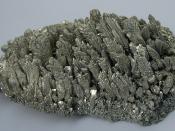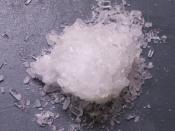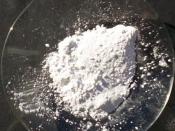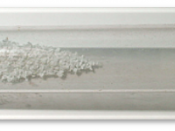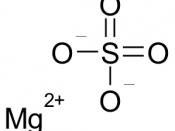Magnesium is a versatile element that has found its way into many facets of our lives. Magnesium is used in various products that can be found in most homes. It also has diverse industrial uses from automotive applications to pyrotechnics. With a greater understanding of magnesium, all of its uses and benefits can be better understood.
Like all elements, some basic information about magnesium can be found on the periodic table of the elements. Magnesium's chemical symbol is Mg. It has an atomic number of 12 and an atomic weight of 24.305 amu. It will melt at 649 degrees Celsius and boil at 1,090 degrees Celsius. Magnesium has an electronegativity of one point two and an oxidation state of two. The last two pieces of information that can be found on the periodic table are the density, which is one point seven three eight g/cm3, and the electron configuration of [Ne]3s2 (Spectrum Chemicals, 2002).
Magnesium was discovered in 1808 by a British chemist, Sir Humphrey Davy. Davy used electrolysis to separate pure magnesium from magnesium oxide, commonly called magnesia. This method is still the main procedure used for magnesium processing today. Compounds containing magnesium, such as Epsom salt and milk of magnesia, have long been known. A farmer from Epsom, England discovered Epsom salt in 1618. His cows would not drink from a mineral well on the farm because the water was very bitter due to a high concentration of Epsom salt. Epsom salt is a hydrated form of magnesium sulfate. The salt is used to treat certain rashes of the skin (Stwertka, 1996).
The physical appearance of magnesium can be described as a silvery, white metal, and is extremely lightweight as compared to other metals. Magnesium is tough but at the same time is also malleable when heated. Magnesium will tarnish if introduced to air. If made into a fine powder it will ignite when introduced to flame producing a brilliant white light. Although magnesium is the eighth most abundant element in the earth's crust, it is never found in its pure form in nature. Magnesium can be found in minerals such as magnesite and dolomite or it can be extracted from seawater. One cubic mile of seawater contains about twelve billion pounds of magnesium. This makes seawater extraction the preferred method of magnesium production and is the main source of all magnesium refined today (Infoplease.com, 2002).
Because magnesium is the lightest metal, it can be used in applications where a high strength to low weight ratio is essential. Magnesium has a density about one fifth that of iron and two thirds that of aluminum. It is usually combined with one of these metals to form a lighter stronger alloy as compared to use of either iron or aluminum alone. Commercially magnesium is used in rocket and aircraft construction, automotive parts, and incendiary bombs. In residential settings magnesium can be found in portable power tools, racing bikes, and most antacid products. At one time magnesium was principally used for photographic flash bulbs. Today compounds like magnesium carbonate, magnesium hydroxide, and magnesium sulfate have found many different roles in our society. Magnesium carbonate is an odorless white powder used in pharmaceuticals, as a food additive, and also for cosmetics. A suspension known as milk of magnesia is magnesium hydroxide mixed with water, this mixture is commonly used as an antacid or a laxative. Magnesium sulfate is used in the manufacture of cement and fertilizers. Magnesium is also vital to the survival of all living organisms. Magnesium is a component of chlorophyll. Chlorophyll is a chemical plants use to produce food from sunlight. In animals, magnesium is involved in several enzyme reactions that deal with the transfer of energy in cells (Encyclopedia Britannica CD-ROM, 2002).
Magnesium has changed the face of our world today for the better. Lightweight magnesium alloys can now be used in place of weaker plastics and wood that were once used in products with weight restrictions. Dazzling firework displays can be created with the intense white light of burning magnesium. All forms of life on earth depend on magnesium to assist in the production of energy. Through research and development, knowledge of magnesium is continually expanding and new uses for this indispensable element are found.

